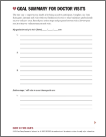Patient
resources.
Explore patient testimonials and educational resources designed to help you. We periodically add new resources to this page. Be sure to check in again soon for new materials.
Actor Portrayals
Videos
Learn About Peter and Kelly’s Journey
NOURIANZ Overview Video
How NOURIANZ Works
Find out more about how to take NOURIANZ
TAKING NOURIANZDownloadable Materials
These resources include helpful information about NOURIANZ and the role of adenosine in Parkinson’s disease (PD).
NOURIANZ BROCHURE
A helpful guide for patients considering NOURIANZ, explaining what it is
and how it works.
DOCTOR DISCUSSION GUIDE
A tool to help you recognize the impact of the “off” time you may be
experiencing with Parkinson’s disease (PD), and how to talk
to your
doctor about it.



WELLNESS TEAM CONTACT INFORMATION ORGANIZER
A convenient form to help you keep track of the names, addresses, and
phone numbers of your healthcare providers. Reprinted and
provided with
permission by the Davis Phinney Foundation.



GOAL SUMMARY FOR DOCTOR’S VISITS
A useful form to help you set wellness goals with your doctor and track
your progress between visits. Filling out a new form for
each doctor visit
can help you create a record of your
progress over time. Reprinted and
provided with permission
by the Davis Phinney Foundation.
Frequently Asked Questions
- What is an “off” episode, or “off” time?
-
Can NOURIANZ® reduce
“off” time?
-
In clinical trials, adult patients with Parkinson's disease (PD) who took NOURIANZ with levodopa, with or without other PD medications, had less “off” time. See NOURIANZ clinical trial results.
-
-
What are the possible side effects of NOURIANZ?
-
NOURIANZ may cause serious side effects,
including:-
uncontrolled sudden movements
(dyskinesia). Uncontrolled sudden movements is one
of the most common side effects. NOURIANZ may cause uncontrolled
sudden movements or make such movements you already have worse
or more
frequent. Tell your healthcare provider if this happens. -
hallucinations and other symptoms of
psychosis. NOURIANZ can cause abnormal thinking and
behavior, including:
- being overly suspicious or feeling people want to harm you (paranoid ideation)
- believing things that are not real (delusions)
- seeing or hearing things that are not real (hallucinations)
- confusion
- increased activity or talking (mania)
- disorientation
- aggressive behavior
- agitation
- delirium (decreased awareness of things around you)
If you have hallucinations or any other abnormal thinking or behavior, talk with your healthcare provider.
- unusual urges (impulse control or compulsive behaviors). Some people taking NOURIANZ get urges to behave in a way unusual for them. Examples of this are unusual urges to gamble, increased sexual urges, strong urges to spend money, binge eating, and the inability to control these urges.
If you notice or your family notices that you are developing any new or unusual symptoms or behaviors, talk to your healthcare provider.
The most common side effects of NOURIANZ include uncontrolled movements (dyskinesia), dizziness, constipation, nausea, hallucinations, and problems sleeping (insomnia).
These are not all the possible side effects of NOURIANZ.
Call your doctor for medical advice about side effects. You may report side effects to FDA at 1-800-FDA-1088, or at www.fda.gov/medwatch.
-
uncontrolled sudden movements
(dyskinesia). Uncontrolled sudden movements is one
of the most common side effects. NOURIANZ may cause uncontrolled
sudden movements or make such movements you already have worse
or more
-
-
What should my healthcare provider know before
deciding if NOURIANZ may be right for me?
-
Before you take NOURIANZ, tell your healthcare provider about all your medical conditions, including if you:
- have a history of abnormal movement (dyskinesia)
- have reduced liver function
- smoke cigarettes or use other tobacco products
- are pregnant or plan to become pregnant. NOURIANZ may harm your unborn baby
- are breastfeeding or plan to breastfeed. It is not
known if NOURIANZ passes into breast milk.
You and your healthcare provider should decide if you will take NOURIANZ or breastfeed
Tell your healthcare provider about all the medicines you take, including prescription and over-the-counter medicines, vitamins, and herbal supplements.
NOURIANZ and other medicines may affect each other causing side effects. NOURIANZ may affect the way other medicines work, and other medicines may affect how NOURIANZ works.
Know the medicines you take. Keep a list of them to show your healthcare provider and pharmacist when you get a new medicine.
-
-
How should NOURIANZ be taken?
-
- Take NOURIANZ exactly as your healthcare provider tells you to
- Take NOURIANZ one time each day
- You can take NOURIANZ with or without food
- If you take too much NOURIANZ, call your healthcare provider or go to the nearest hospital emergency room right away
-
-
What are the ingredients in
NOURIANZ?
-
The active ingredient in NOURIANZ is istradefylline. The inactive ingredients are crospovidone, lactose monohydrate, magnesium stearate, microcrystalline cellulose, polyvinyl alcohol, hypromellose, polyethylene glycol 3350, titanium dioxide, triacetin, iron oxide red, iron oxide yellow, and carnauba wax.
-
-
Is there financial support for out-of-pocket
treatment costs for NOURIANZ?
-
If your doctor has prescribed NOURIANZ and you need help with the out-of-pocket cost, the Kyowa Kirin Cares program may be able to help.
Eligible commercially insured patients may pay as little as $20 for a 1-month supply of NOURIANZ. For full program eligibility requirements, terms, conditions, and limitations, click here.
Kyowa Kirin Cares also provides information, support, and other resources to eligible patients. For more information about Kyowa Kirin Cares, click here.
If you need help paying for NOURIANZ, the Kyowa Kirin Cares program may be able to help you get the information and resources you need to start and stay with NOURIANZ.
Visit Kyowa Kirin Cares for more information, including full eligibility requirements, terms, and conditions.
-
Organizations for patients with Parkinson’s disease (PD) and their care partners
*Kyowa Kirin proudly sponsors the organization’s initiatives and goals through funding support.
The Michael J. Fox Foundation
www.michaeljfox.orgDedicated to finding a cure and ensuring the development of improved therapies
Parkinson’s Foundation*
www.parkinson.orgTo make life better through improved care and advance research for a cure
American Parkinson Disease Association
www.apdaparkinson.orgProvides information, education, support, activities, events, and referrals
Davis Phinney Foundation For Parkinson’s*
www.davisphinneyfoundation.orgFunds essential information, tools, inspiration for those living with PD, as well as research on exercise, speech, movement, and more
Parkinson & Movement Disorder Alliance
www.pmdalliance.orgProvides opportunities for meaningful connections through
national, independent non-profit funding
What is NOURIANZ?
NOURIANZ is a prescription medicine used with levodopa and carbidopa to treat adults with Parkinson’s disease (PD) who are having “off” episodes. It is not known if NOURIANZ is safe and effective in children.
Important Safety Information
Before you take NOURIANZ, tell your healthcare provider about all your medical conditions, including if you:
- have a history of abnormal movement (dyskinesia)
- have reduced liver function
- smoke cigarettes
- are pregnant or plan to become pregnant. NOURIANZ may harm your unborn baby
- are breastfeeding or plan to breastfeed. It is not known if NOURIANZ passes into breast milk. You and your healthcare provider should decide if you will take NOURIANZ or breastfeed
Tell your healthcare provider about all the medicines you take, including prescription and over-the-counter medicines, vitamins, and herbal supplements.
NOURIANZ and other medicines may affect each other causing side effects. NOURIANZ may affect the way other medicines work, and other medicines may affect how NOURIANZ works.
What are the possible side effects of NOURIANZ?
NOURIANZ may cause serious side effects, including:
- uncontrolled sudden movements (dyskinesia). Uncontrolled sudden movements is one of the most common side effects.
- hallucinations and other symptoms of psychosis. NOURIANZ can cause abnormal thinking and behavior, including:
- being overly suspicious or feeling people want to harm you (paranoid ideation)
- believing things that are not real (delusions)
- seeing or hearing things that are not real (hallucinations)
- confusion
- increased activity or talking (mania)
- disorientation
- aggressive behavior
- agitation
- delirium (decreased awareness of things around you)
- unusual urges (impulse control or compulsive behaviors). Some people taking NOURIANZ get urges to behave in a way unusual for them. Examples of this are unusual urges to gamble, increased sexual urges, strong urges to spend money, binge eating, and the inability to control these urges.
If you notice or your family notices that you are developing any new or unusual symptoms or behaviors, talk to your healthcare provider.
The most common side effects of NOURIANZ include uncontrolled movements (dyskinesia), dizziness, constipation, nausea, hallucinations, and problems sleeping (insomnia).
These are not all the possible side effects of NOURIANZ.
Call your doctor for medical advice about side effects. You may report side effects to FDA at 1-800-FDA-1088 or www.fda.gov/medwatch.
Please see Patient Information for NOURIANZ.





